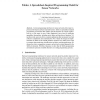DCOSS
2010
Springer
14 years 4 months ago
2010
Springer
A number of wireless sensor network (WSN) applications demand timely data delivery. However, existing WSNs are designed to conserve energy and not to support timely data transmissi...
DCOSS
2010
Springer
14 years 5 months ago
2010
Springer
Most sensor network applications are dominated by the acquisition of sensor values. Due to energy limitations and high energy costs of communication, in-network processing has been...
DCOSS
2010
Springer
14 years 5 months ago
2010
Springer
Sensor network MAC protocols are typically configured for an intended deployment scenario once and for all at compile time. This approach, however, leads to suboptimal performance...
DCOSS
2010
Springer
14 years 5 months ago
2010
Springer
Abstract. We consider the problem of multihop broadcast over adaptively duty-cycled wireless sensor networks (WSNs) where neighborhood nodes are not simultaneously awake. We presen...
DCOSS
2010
Springer
14 years 5 months ago
2010
Springer
Abstract. Current programming interfaces for sensor networks often target experienced developers and lack important features. Tables is a spreadsheet inspired programming environme...
DCOSS
2010
Springer
14 years 5 months ago
2010
Springer
We propose to use mobile phones carried by people in their everyday lives as mobile sensors to track mobile events. We argue that sensor-enabled mobile phones are best suited to de...
DCOSS
2010
Springer
14 years 5 months ago
2010
Springer
Abstract. Target tracking is a typical and important application of wireless sensor networks (WSNs). In the consideration of scalability and energy efficiency for target tracking ...
DCOSS
2010
Springer
14 years 5 months ago
2010
Springer
Abstract. The success of high-level programming models in Wireless Sensor Networks (WSNs) is heavily dependent on factors such as ease of programming, code well-structuring, degree...
DCOSS
2010
Springer
14 years 5 months ago
2010
Springer
One vision of an opportunistic sensor network (OSN) uses sensor access points (SAPs) to assign mobile sensors with sensing tasks submitted by applications that could be running any...

